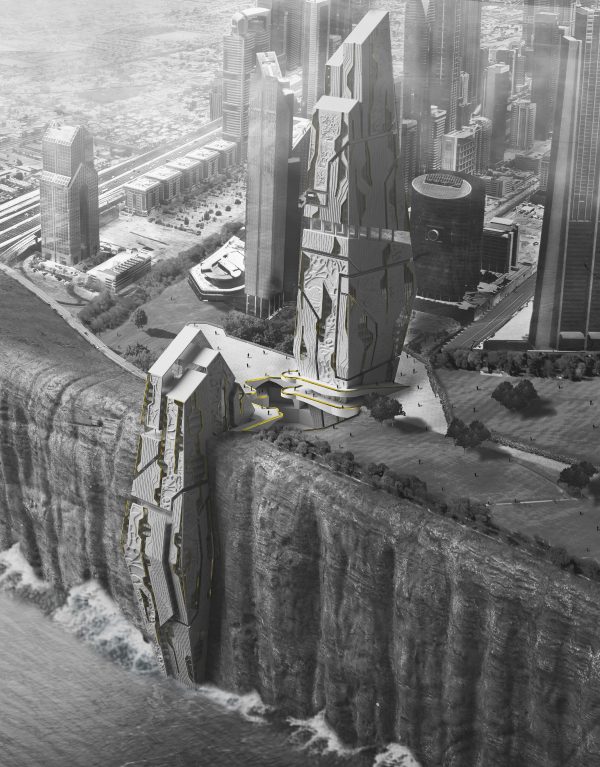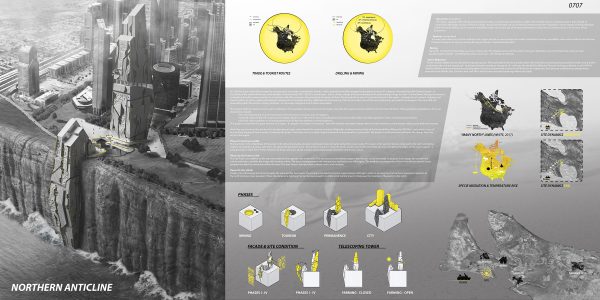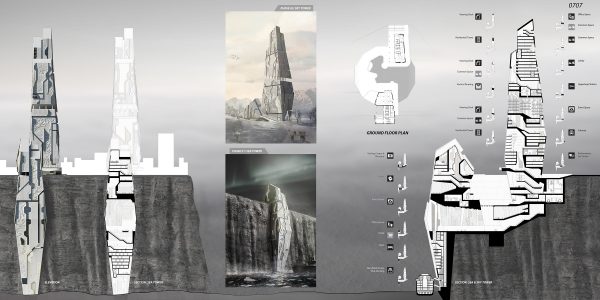Honorable Mention
2018 Skyscraper Competition
BoSheng Liu, Jon Rankin, Bryan Daily
United States
By 2300 the Arctic north will no longer be a sequestered, seemingly uninhabitable, frontier – with a projected annually averaged temperature increase of 15 degrees Fahrenheit by 2099 (GlobalChange) – as two-thirds of the world will become uninhabitable. (CleanTechnica) (IPCC) (NCA) In recent years – due to climate change and rapid warming of the polls leading to large ice melt – the Northwest Passage has become navigable during the warmer months. In conjunction with this occurrence the permafrost has begun to thaw. This has lead to an array of corporate interest in the region – ranging from oil, mineral, shipping, and tourist entities, as well as, nations attempting to pioneer the circumpolar territory. (ENR) Now the land and sea of the Arctic north is one of the most contentious geo-political campaigns of our time that will inexorably impact the world in coming centuries – in some ways malignant and in others benevolent.
This project addresses those concerns with an initiation of the paradoxes being enacted on the region, and what the project presumes will occur in the projected future. These paradoxes and dialectics, from our observation, include:
● the site initially being a tourist destination which becomes a necessary area of migration
● the local culture being self-sustaining and largely operating on “old world” means of trading but must interact with modern societies capitalistic means of monetary transactions
● the local culture operates on a hunting system but will become gatherers as time progresses.
This project accounts for the space and time of a region – it’s people, it’s context, it’s evolution – that will inevitably encounter change when the Earth continues on the climatic trajectory set forth by humanity.
Arctic Bay was chosen as the site due to it already being a largely visited hamlet for summer activities (Wikipedia), existing mining activity of the Nansivik Mine (Wikipedia) (DKJ.Min), and potential ease of access along shipping & tourist routes. To develop the project a fictitious mine is created using the Nansivik mining operation as precedent. The project is multi-phased to anticipate the change that may occur in the region.
Phase 01: Sea Tower (2050)
The Sea Tower is the initial phase of the project’s life where the tourists are given a permanent area of respite along their cruise routes. This tower is the nascent intrusion of people to the north who bring modern societal ideas & values with them. An abstracted panelized stone – derived from Innuit art – clads the tower. Locally sourced from the Nansivik mine and gilting the edges of this tower is pyrite – a pseudomorph or “false form”. These material and design decisions allude to phase one’s programmatic alienation of the local culture.
Phase 02: Sky Tower (2150)
The Sky Tower is an addition to the sea tower added to the opposite side of the mine. This structure accommodates program that focuses on societal needs. Its purpose is to engage the current Inuit culture and help to mediate the merge with western culture. The tower is programmed with hydroponics, residential, and office space. The emphasis on pragmatism is fused with the sea tower’s luxury program through the connection within the mine. This area houses transportation, cultural center, and museum.
Phase 03: City (2250)
Finally a city will emerge and circumnavigate the mine and the two towers. The program provided by the two original towers will help to usher in an economy that can be sustained as migration to the north becomes more prevalent. These structures set a typology that can be repurposed in multiple arctic mining towns to help ease the transition of humanity to the north.

















